Egyptian Pyramids
There are many pyramids across Egypt, and if I ever make it back, I hope to see more of them, but I did get to see THE pyramids. THE pyramids being the ones on the Giza plateau in greater Cairo. These are the pyramids that were on the original list of the 7 wonders of the world. There were various iterations of this list – essentially a travel guide for the Ancient Greeks. When the 7 wonders were defined, the pyramids were almost 2000 years old already and another 2,000 years has passed since. That’s how incredibly old the pyramids are. And today, the only wonder of the ancient world that survives is the pyramids at Giza.
The last leg of our journey on local transport was a taxi. Being stuffed in the middle of a large station wagon taxi, I never got a peek at the pyramids that a few of the others in our group did. Instead this photo immortalizes my first view of the largest of the 3 pyramids, the tomb of the Pharaoh Khufu. With the sun ahead of us, the only image I could possibly get shooting into the sun was a silhouette, but I made the best of it, casting my entire group of travel companions into silhouette as we marched up that hill to the pyramids. I believe it makes for an incredibly dramatic print, which the great pyramid deserves!
Khufu was the first of the pyramid builders at Giza. Construction of this pyramid took between 14 and 20 years and was probably completed around 2560 BC. Khufu reigned for 23 years and died in 2566 BC – so his lasting monument was constructed across most of his reign. I have other conventional pictures of this pyramid, but this is the way I will always remember it, golden and silhouetted.
The second pyramid on the plateau at Giza was the tomb of the Pharaoh Khafre. The second pyramid could not outshine the first, so it was purposefully built smaller. Khafre is believed to be the son of Khufu, thus his reign and construction of his pyramid would have followed on the heels of his father’s. As you can see, the top of this pyramid still has a bit of it’s original casing stones intact. All three pyramids would have originally appeared much different than today. What we see is the rough stone core. Originally, smooth limestone was applied to the outside. Some of it weathered away, but much was apparently stolen for building in Cairo in the middle ages. Khafre’s pyramid will always hold a special place for me as this was the one we went inside. Climbing in and out of that dark two way tunnel was quite an experience, but the thing I will most remember is the oppressive atmosphere inside. One of the group inside described it as thrice breathed air. Still, it was absolutely incredible, to stand where an ancient pharaoh was once interred.
Maybe it was some of that thrice breathed air that inspired me to do a photo-art treatment of this particular pyramid picture. I think the textures really enhance the light and make the sky even more dramatic. I went for a very painterly feeling with this work.
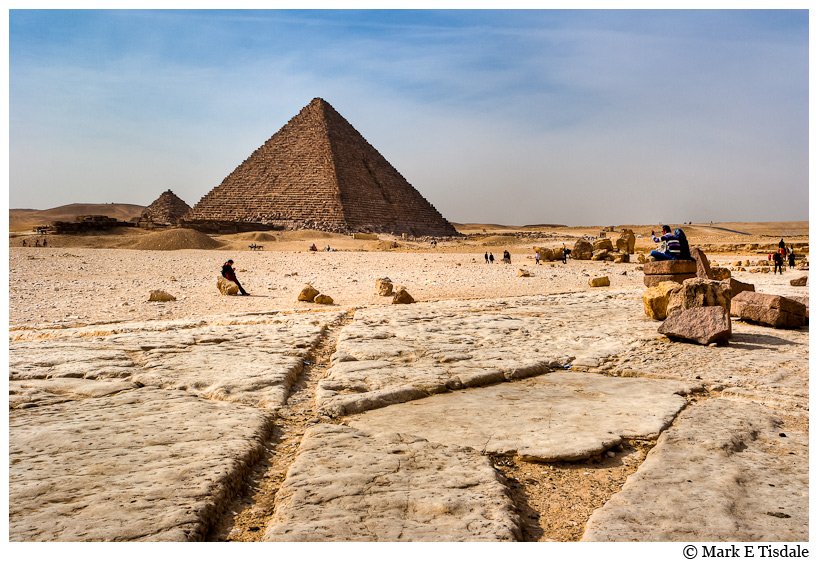
The last and smallest of the three pyramids was for Pharaoh Menkaure. There’s conflicting accounts of whether Menkaure was the son of Khafre of Khufu, but he succeeded Khafre as Pharaoh. Two coffins were found within this tomb in modern times. One held bones that were two modern to be the Pharaoh. A sarcophagi was also unearthed from the pyramid but lost in the sinking of a boat bound for Great Britain in 1838. There were smaller pyramids begun adjacent to Menkaure’s tomb, likely for family, but never completed. After the pyramid pictured, no further were built at Giza.
The last thing we saw before leaving the plateau was one of the most enigmatic, the famous Sphinx as pictured above. The best theory so far seems to be that the Sphinx was built by Khafre, possibly in his image. It was carved from solid stone on-site. It’s generally believed that there was a rock adjacent to the pyramid and the solution to removing the obstruction was to make it a monument itself. The pyramids seen behind in this shot are left to right, Menkaure and Khafre. Even now looking at these photos and remembering being there, it seems something like a dream. One of those things you see on TV and read about and never dream you’ll actually stand there, and I’m happy that I took the opportunity to visit. Maybe it was the timeless nature of the Sphinx and pyramids that inspired the vintage feel I applied to this panorama of the greatest monuments of Egypt!
You can see more prints from my adventure in Egypt in the Egypt Gallery.



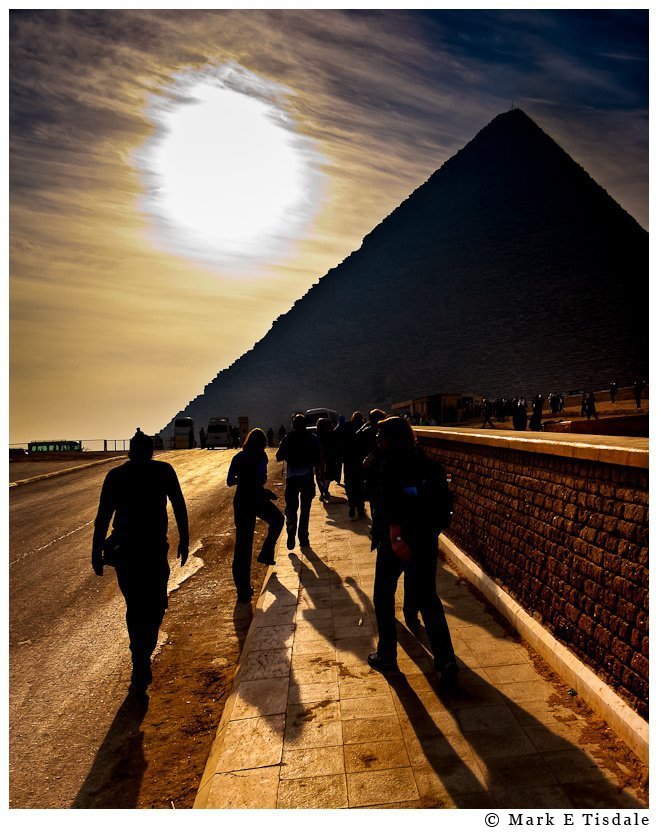
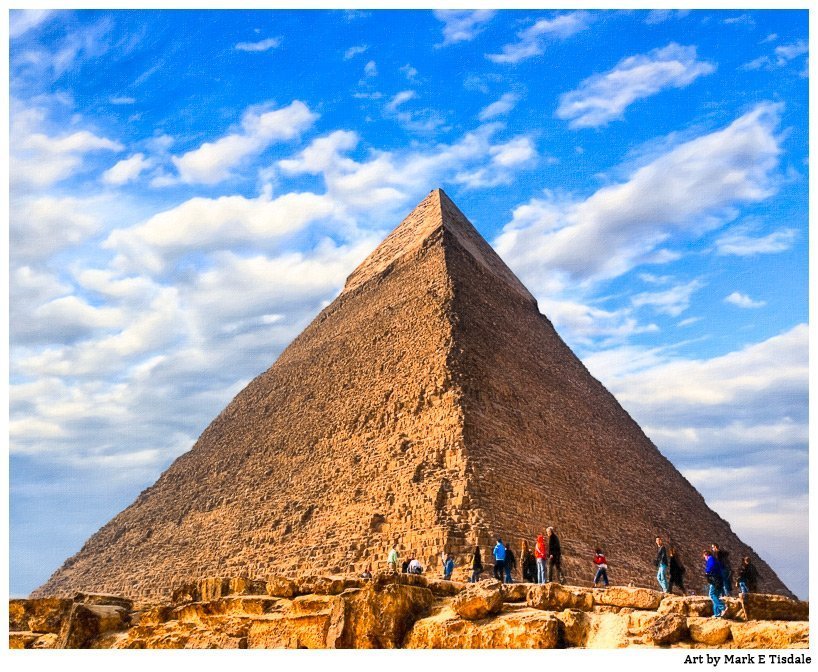
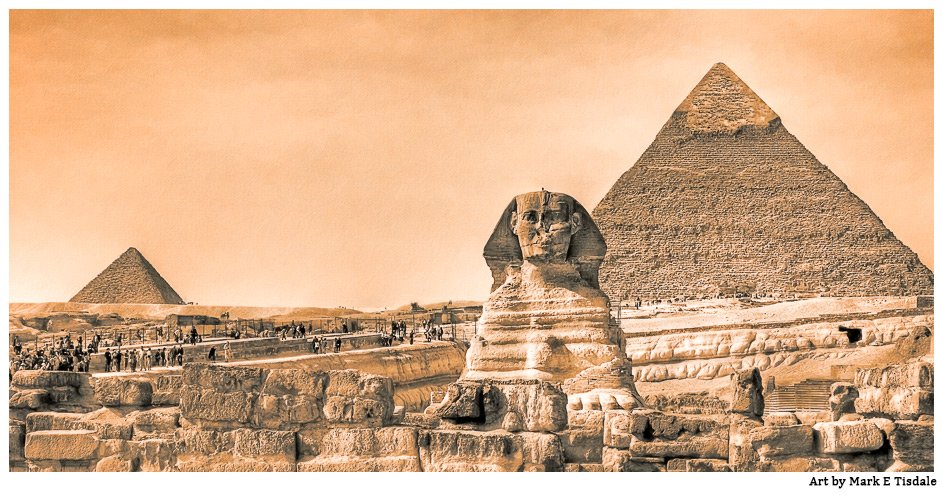
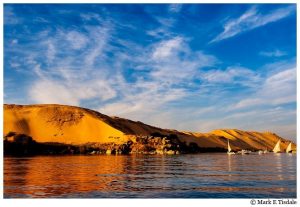
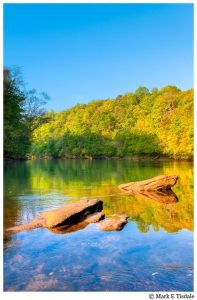
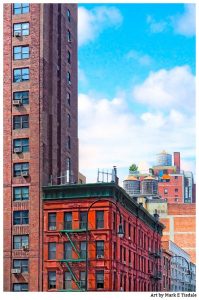



Hi Mark,
we’re looking for some art for our new office. Have added you to the short list. Once we’ve decided will let you know. If your interested will send you some pics of them in situ for your blog.
Ty
Mike
Mike – Appreciate being included for consideration! And yes, please, I would love photos of the the prints in your office if chosen.
If you have any questions, etc., don’t hesitate to ask. Thanks.